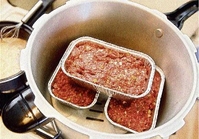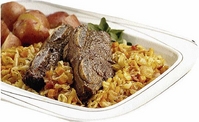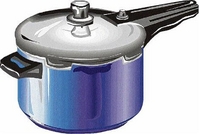Maximising your pressure cooker
Published: Saturday | October 10, 2009

A pressure cooker can be used to cook meatloaves, stacked in mini-loaf pans, in just 15 minutes.
'Slow-cooked in a hurry', 'full-bodied' and 'fast food without guilt' are apt descriptions for meals prepared in the pressure cooker. Pressure-cooking saves you time by cooking foods two to 10 times faster than ordinary cooking methods. In fact, it is the fastest way to cook delicious food.
Contemporary pressure cookers are as fast or faster than microwave ovens, but the food from the pressure cooker tastes tremendously better. When you spend less time cooking, it means more time for sports, children, movies, friends, hobbies or other activities. Pressure should play a very important role in your food preparation, given its ability to provide new flavours for food as well as saving energy at a time when conservation is so critical.
Operating the pressure cooker is easy and it is important that you read and follow the instructions that come with it. Pressure cookers are made from aluminium or stainless steel. Stainless-steel models, as they are generally higher quality, heavier pots, resulting in better cooking with less danger of food sticking to the bottom. The heavier stainless-steel models are also great because you can brown or sauté foods in them before cooking under pressure and without using another pot.
Fast cooking

Short ribs prepared in a pressure cooker save time and provide a soul-warming entrée. - MCT Photos
A pressure cooker can cook the same types of delicious recipes that a slow cooker can - and substantially faster. The pressure cooker is quite the opposite of the slow cooker. As the name slow cooker implies, it cooks food very slowly, usually taking around eight hours for most foods. In contrast, a pressure cooker does the job extremely quickly, taking only a matter of a few minutes, but still giving you the same flavourful taste as a slow cooker.
History
The history of pressure cookers dates back to Europe where they were
Steam cooking
Pressure-cooking is a cooking method that uses steam sealed in a pressure cooker, which is a special airtight cooking pot. Sealing a liquid such as water, wine, stock or broth in a pressure cooker traps the vapour that rises from the liquid. This in turn raises the pressure inside the pressure cooker, along with the maximum temperature that the liquid can reach.
The increased temperature and pressure significantly speed up the cooking process.
The pressure of the trapped steam can be measured in pound of force per square inch, or PSI. You will often find this term in pressure-cooking recipes. It refers to how many pounds of pressure per square inch with which you will be cooking.
An important part that helps with the build-up of pressure in the cooker is the gasket or rubber ring, which works as a seal that traps in steam and heat. The gasket fits on the inside part of the cover. In order to make sure you get a good fit with the seal, make sure all the components are clean and free from food particles.
The parts of the cooker are simple. The pressure cooker has trivets and steaming baskets for steaming vegetables and keeping them whole. Two handles, instead on one, are better for a firmer grip, especially since it may be necessary to move the cooker with food to the sink for pressure release.
The lid is designed to be fitted with a rubber gasket to form an airtight seal once it is locked into position. The gasket expands and releases excess pressure between the lid and the pot. The new cookers have locking lids which prevent pressure from building up if the pot is not properly sealed. This eliminates the almost expected kitchen mishaps of explosions. You may remember in your home how the lid flew off to the horror of grandma, mother or yourself.
Safety valves

The risk of an explosion is reduced as modern cookers have two or three independent safety valves as well interlocking lids which prevent opening the lid while internal pressure exceeds atmospheric pressure.
Other safety methods include a hole in the lid blocked by a plug of low-melting alloy. Another feature is the rubber grommet with a metal insert at the centre. As the pressure increases, the grommet will distort and the insert will blow out of the mounting hole, relieving the pressure. If the pressure gets so high, the grommet itself may blow out. Pressure cookers should be maintained regularly to keep them safe.
CAUTION: You should never leave the pressure cooker on the stove with a flame on
You may remember pressure cookers as steaming, spitting monsters of a pot, noisily rattling on the kitchen stove. Pressure cookers are much quieter today - no rattling noise - so your neighbour will not know when you are preparing meal favourites like oxtail. Today's pressure cookers only give off gentle hissing sounds from the weight applying pressure on the top of the cooker.
Cooking certain foods
You may cook from A to Z in your pressure cooker - from apple stew to zucchini. Some quick-cooking foods are better prepared by other cooking methods. Pressure cookers are best suited for foods that require long, slow cooking in moist heat. Incidentally, the pressure cooker does not operate depending on the amount of food in the pot. One potato cooks as quickly as 10 potatoes.
Unsoaked dried peas or beans will cook in less than 30 minutes. Presoaked peas or beans will cook even faster.
Tough, flavourful cuts of meat such as short ribs, pork shoulder or beef shank may require longer cooking to get tender.
Soups, stews and stocks and long-cooking sauces like marinara or ragú should develop flavour in 20 minutes or less. The pressure-cooking process extracts flavours and gelatinises for tasty broths.
Grains such as brown rice and bulgur will cook in 20 minutes compared to 45 minutes. Add a tablespoon of oil or butter per cup of dry grain and fill the cooker just to half of the pot to prevent rice from foaming up and clogging the pores of the cooker.
Sturdy vegetables like potatoes, beets and hardy greens cook quickly after 10 minutes at high pressure.
Advantages of pressure-cooking
There are lots of advantages to using this can't-do-without-it kitchen tool.
Nutritional boost: Due to the shorter cooking time and the fact that food is cooked in less liquid that gets boiled away, more vitamins and minerals are retained than with conventional cooking methods.
Pressure cooking is a healthy way to cook meats, such as poultry, as well as fish, because it speeds up the cooking time. The less time foods are exposed to high temperatures, the more nutrients are preserved. Pressure-cooking is especially good for tougher cuts of meat or for making hearty soups and stews.
Time saving: Food cooks up to 70 per cent faster
Energy-efficient: As less cooking time is needed, less energy will be used to accomplish the task.
Cooler kitchen: As all the steam and heat stay in the pot, your kitchen stays cooler than with traditional stovetop or oven methods.
Cleaner kitchen: As all pressure-cooked foods are done in a covered pot, there are virtually no messy splashes or splatter to clean up.
Releasing Steam
The methods for releasing steam in the new cookers make them far more safe compared to older types. Depending on what you are making, you will release steam and, therefore, pressure from your pressure cooker via the natural-release or quick-release methods. The recipe will tell you which is the preferred method.
Natural-release method: This method means you remove the pressure cooker from the stove and wait for the pressure slowly to ease as the temperature of the pot naturally lowers. Foods like soups or tough cuts of meat benefit from this extra cooking time to make them more
Quick-release method: Some pressure cookers have an automatic-release method. If so, simply follow the instructions to release steam and pressure. If your pressure cooker does not have an automatic-release method, simply release pressure by removing the pressure cooker from the stove to the sink and run cold water over the cover of the pressure cooker until the all the pressure is released.
Cleaning and Storing
Take care of your pressure cooker and it will give you a lifetime of great cuisine. Here are some basic maintenance tips:
Remove the rubber gasket or ring and wash this separately by hand.
Never immerse the cover in water as it can clog and damage the safety valves.
Hand-wash the pot with your favourite dishwashing soap.
Do not store the pressure cooker with the lid locked in place as it can damage the rubber seal. Also, if moisture is present, it can create a seal that is difficult, if not impossible, to open.
You can conveniently store the pressure cooker with the lid placed upside down on top of it. (Fabulous Foods.ca)
Heather Little-White, PhD, is a nutrition and lifestyle consultant in Kingston. Send comments to editor@gleanerjm.com.
Tips for better pressure-cooking
Cooking time is a quarter or one-third of regular cooking methods. Consult the cooker's manual when in doubt or if you want to try a new recipe.
Never fill your pressure cooker more than half-full with foods or two-thirds full of liquid. Foods have a tendency to increase in volume under pressure, so it is important to never overfill your pressure cooker. Most cookers have a mark stamped on the inside that lets you know when you have put in the maximum amount.
Choose recipes which require that all the ingredients be added at the start of cooking. It would be impractical to release the pressure every time you want to add an additional ingredient.
To speed up cooking time to reach full pressure, heat liquids before adding them to the cooker.
Reduce the heat once the pot reaches full pressure. Reduced heat keeps a steady pressure until cooking is finished. Be ready to adjust the stove heat. If the pressure builds too high, you will want to immediately lower the temperature so it comes down. This is
However, if you have a standard electric stove, it is helpful to have one burner set on low heat while you build pressure in the cooker on another burner over high heat. Once you reach the desired pressure, move the pot to the burner with the lower heat in order to maintain the pressure at the desired level.
Begin counting cooking times from when the pressure cooker has reached the full pressure.
For foods that may overcook easily, use the quick-release feature on the cooker or move to the sink quickly and cool down with running water to reduce the pressure.
When cooking beans, potatoes or other foods with skins, use the natural-release method (removing the pot from the flame allowing the pressure to drop gradually) if you want to keep the skins intact. Use this method also for beef which may become tough if the pressure is released too quickly.
For extra flavour, brown or sauté foods first, just as you would when cooking with conventional methods. For instance, brown the meat and seasonings for a soup before adding other liquids and cooking.
Increase cooking times slightly at high altitudes of 2,000 feet or more above sea level. It is suggested that cooking times be increased by five per cent for every 1,000 feet above sea level of 2,000 feet.
Lemon Cheesecake
Makes one 7-inch cheesecake
2-3 tbsps (30-45ml) butter
1 cup (250ml) Graham wafer crumbs
12oz (340g) cream cheese, at room temperature
1/2 cup (125ml) sour cream
1/2 cup (125ml) sugar
2 large eggs
1 tsp (5ml) lemon juice
1 tsp (5ml) grated lemon zest
1/2 tsp (2ml) vanilla extract
alternatively, chocolate wafer crumbs or animal cracker crumbs
